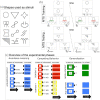Transitions from avoidance: Reinforcing competing behaviours reduces generalised avoidance in new contexts
- PMID: 32686989
- PMCID: PMC7672781
- DOI: 10.1177/1747021820943148
Transitions from avoidance: Reinforcing competing behaviours reduces generalised avoidance in new contexts
Abstract
Generalised avoidance behaviours are a common diagnostic feature of anxiety-related disorders and a barrier to affecting changes in anxiety during therapy. However, strategies to mitigate generalised avoidance are under-investigated. Even less attention is given to reducing the category-based generalisation of avoidance. We therefore investigated the potential of an operant-based approach. Specifically, it was examined whether reinforcing competing (non-avoidance) behaviours to threat-predictive cues would interfere with the expression of generalised avoidance. Using a matching-to-sample task, artificial stimulus categories were established using physically dissimilar nonsense shapes. A member of one category (conditioned stimulus; CS1) was then associated with an aversive outcome in an Acquisition context, unless an avoidance response was made. Next, competing behaviours were reinforced in response to the CS1 in new contexts. Finally, we tested for the generalisation of avoidance to another member of the stimulus category (generalisation stimulus; GS1) in both a Novel context and the Acquisition context. The selective generalisation of avoidance to GS1 was observed, but only in the Acquisition context. In the Novel context, the generalisation of avoidance to GSs was significantly reduced. A comparison group (Experiment 2), which did not learn any competing behaviours, avoided GS1 in both contexts. These findings suggest that reinforcing competing behavioural responses to threat-predictive cues can lead to reductions in generalised avoidance. This study is among the first study to demonstrate sustained reductions in generalised avoidance resulting from operant-based protocols, and the clinical and research implications are discussed.
Keywords: Avoidance; anxiety; category-based generalisation; generalisation.
Conflict of interest statement
Figures





Similar articles
-
Conditioned generalisation in generalised anxiety disorder: the role of concurrent perceptual and conceptual cues.Cogn Emot. 2021 Dec;35(8):1516-1526. doi: 10.1080/02699931.2021.1982677. Epub 2021 Oct 4. Cogn Emot. 2021. PMID: 34602017
-
Fear learning, avoidance, and generalization are more context-dependent for adults than adolescents.Behav Res Ther. 2021 Dec;147:103993. doi: 10.1016/j.brat.2021.103993. Epub 2021 Oct 30. Behav Res Ther. 2021. PMID: 34740098
-
Fearing shades of grey: individual differences in fear responding towards generalisation stimuli.Cogn Emot. 2017 Sep;31(6):1181-1196. doi: 10.1080/02699931.2016.1204990. Epub 2016 Jul 12. Cogn Emot. 2017. PMID: 27405100
-
Revisiting the role of anxiety in the initial acquisition of two-way active avoidance: pharmacological, behavioural and neuroanatomical convergence.Neurosci Biobehav Rev. 2020 Nov;118:739-758. doi: 10.1016/j.neubiorev.2020.08.014. Epub 2020 Sep 9. Neurosci Biobehav Rev. 2020. PMID: 32916193 Review.
-
Overcoming avoidance in anxiety disorders: The contributions of Pavlovian and operant avoidance extinction methods.Neurosci Biobehav Rev. 2019 Mar;98:61-70. doi: 10.1016/j.neubiorev.2019.01.007. Epub 2019 Jan 7. Neurosci Biobehav Rev. 2019. PMID: 30629978 Review.
Cited by
-
Decentering as a core component in the psychological treatment and prevention of youth anxiety and depression: a narrative review and insight report.Transl Psychiatry. 2021 May 14;11(1):288. doi: 10.1038/s41398-021-01397-5. Transl Psychiatry. 2021. PMID: 33990541 Free PMC article. Review.
-
Excessive generalization of pain-related avoidance behavior: mechanisms, targets for intervention, and future directions.Pain. 2023 Nov 1;164(11):2405-2410. doi: 10.1097/j.pain.0000000000002990. Epub 2023 Jul 27. Pain. 2023. PMID: 37498749 Free PMC article. No abstract available.
-
Generalization of pain-related avoidance behavior based on de novo categorical knowledge.Pain. 2023 Apr 1;164(4):895-904. doi: 10.1097/j.pain.0000000000002786. Epub 2022 Sep 20. Pain. 2023. PMID: 36149790 Free PMC article.
References
-
- Assaz D. A., Roche B., Kanter J. W., Oshiro C. K. (2018). Cognitive defusion in acceptance and commitment therapy: What are the basic processes of change? The Psychological Record, 68(4), 405–418.
-
- Bennett M. P., Hermans D., Dymond S., Vervoort E., Baeyens F. (2015). From bad to worse: Symbolic equivalence and opposition in fear generalisation. Cognition and Emotion, 29(6), 1137–1145. - PubMed
-
- Boddez Y., Bennett M. P., van Esch S., Beckers T. (2017). Bending rules: The shape of the perceptual generalisation gradient is sensitive to inference rules. Cognition and Emotion, 31(7), 1444–1452. - PubMed
MeSH terms
LinkOut - more resources
Full Text Sources
Miscellaneous

